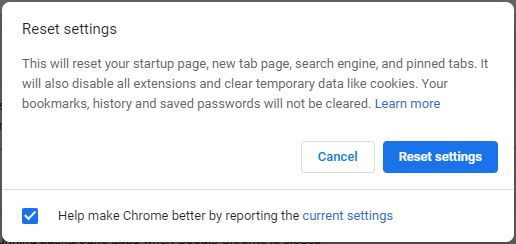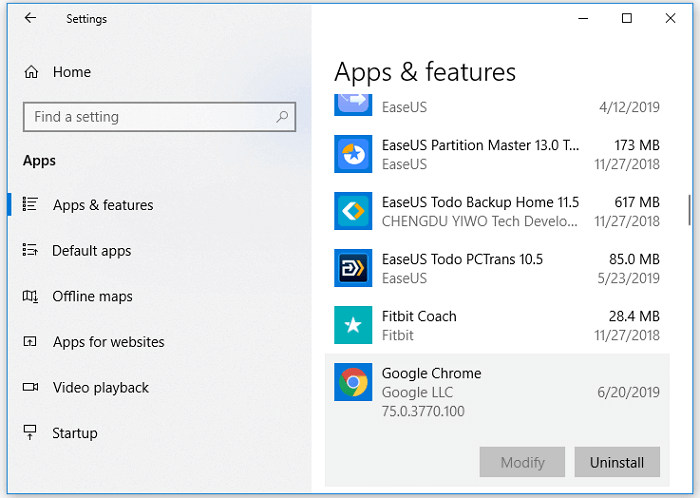[Fixed] Google Chrome Not Downloading Files
On this page, you'll find two parts of solutions - both simple & advanced to help you fix Google Chrome Not Downloading Files error. If your Chrome is now downloading files, pick any method here to get rid of this issue on your own:
| Workable Solutions | Step-by-step Troubleshooting |
|---|---|
| Quick Tips for Chrome Won't Download Files | Check if the internet connection is working; Restart Chrome; or try to download files again; ask for...Full steps |
| Further Fix 1. Do Basic Cleaning | You can clear history and cache in Google Chrome; run the Chrome cleanup tool; or reset Chrome...Full steps |
| Further Fix 2. Disable Hardware Acceleration | Go to Chrome Settings > Advanced Settings > Uncheck "Use hardware acceleration when available"...Full steps |
| Further Fix 3. Reinstall Google Chrome | Uninstall Google Chrome in "Apps & features" > Delete all Google folders in Registry > Reinstall Chrome...Full steps |
| Further Fix 4. Disable Unused Extensions | Open Chrome > Go to "More" > "More tools" > "Extensions" > Disable downloading related extensions...Full steps |
User Case: Google Chrome Won't Download Files Anymore
"Why won't Google Chrome let me download files anymore? I used to download email attachments, pictures and music very easily. Since last week, it's no longer downloading any type of file from any website. What's the matter?"
Google Chrome is so simple and powerful that everyone loves it. But recently I found that one issue is under heated discussion on some major-related forums: Google Chrome is not downloading files!
After clicking the download button/icon on a web page, the request is not responding. Or, while selecting a location to preserve the download(s), the required download prompt box doesn't appear as usual. After many searches on the internet, Chrome fans said that they still don't find a confirmed solution to solve the problem.
Learn Chrome History & Bookmarks Recovery First
Some of the fixing methods will restore your browser to its original defaults or delete the Google folder. If the browsing history or bookmarks were unfortunately removed. Don't panic though, we left a data recovery plan to assist you to recover Chrome history in Windows and restore Chrome bookmarks on Mac.
Since Google has a temporary folder that stores some cache files related to browsing history and bookmarks, you can use Deep Data Recovery, one of the most powerful third-party hard drive recovery software, to restore missing or lost Chrome data from its temporary folder, even the folder has been deleted on a local disk.
Qiling file recovery tool has the following salient features:
- Recover permanently deleted files on Windows 10 and Windows 11
- Recover more than 1000+ file types from HDD, SSD, SD card, pen drive, USB flash drive, external hard drive, etc.
- Recover deleted files on Mac after emptying Trash Bin
- Repair corrupted files on Windows and Mac, including repair corrupted photos, videos, and documents
Free download this file recovery software to recover lost files with ease.
Step 1. Select file types
Launch Deep Data Recovery. Select file types and click "Next" to start.

Step 2. Select a drive and start scanning
Hover over the partition where you lost data. This could be an internal hard disk, external disk, USB, or SD card. Then, click "Scan".

Step 3. Check and preview scanned files
Use the file format filter on the left or upper right corner to narrow the scan results until you find the files you need. Then, you can click the "Preview" button or double-click a file to preview its content, if you'd like.

Step 4. Recover lost data to a secure location
Click the checkbox next to the file and click "Recover" to restore the lost data to a secure place. We recommend that you do not store the recovered data on the disk where you lost it earlier.
Here we introduce multiple ways to fix Google Chrome not downloading files, including simple tips you can try first and further troubleshooting tips. Hope it works and your favorite browser is getting back to normal.
Quick Tips to Solve Fix Chrome Won't Download Files Issue
According to Google Chrome Help page about how to fix file download errors in Google Chrome, if you get an error message on Chrome when you try to download apps, themes, or other files, try to fix the most file download errors with the troubleshooting tips:
- Make sure your Internet connection is working normally. Fix Internet stability issues if the connection is unstable
- Try to download the file later
- Contact the website owner
There, on the linked page, you can find more 'error messages' related to this problem in downloading files with Chrome, such as Chrome network failed, download blocked, no file, virus scan failed, disk full, insufficient permissions, system busy, needs authorization or forbidden. All those errors are responsible for Chrome not being able to download files.
If the easy tips above fail to solve the problem, don't get upset. There are other potential solutions provided below for you to fix the "Chrome not downloading files" issue.
Further Fixes for "Chrome Not Downloading Files" Error
Some people are not so lucky, they can't finish any download in Chrome. What's worse, they fail to download files without receiving a warning or error message indicating where the process went wrong. In this case, it's time to take some further measures. After reading numerous stories telling how people fix the downloading problems in Chrome, we summed up four effective solutions which I hope to be a permanent cure.
Method 1. Do Some Basic Cleaning Works
These are what you can try: clear all history and cache, run the Chrome cleanup tool, and reset settings to Chrome's original defaults. If you want to keep your Chrome history and cookies, you can backup or export Chrome history and cookies in advance.
To Clear history and cache in Google Chrome:
Step 1. Open Chrome on your computer and go to "More (three dots)" > "More tools" > "Clear browsing data...".
Step 2. Check the content you want to remove and click "Clear Data".

To Run the Chrom cleanup tool:
A Chrome cleanup tool can find and remove harmful software on your computer. Running this tool may solve the "Chrome won't download files" issue caused by malware.
Step 1. Open Google Chrome on your computer.
Step 2. In the top right corner, click "More (three dots)" > "Settings".
Step 3. Scroll down to the bottom and click "Advanced".
Step 4. Under "Reset and clean up", click "Clean up computer" > "Find".

To reset Chrome:
Step 1. Open Google Chrome on your computer.
Step 2. In the top right corner, click "More (three dots)" > "Settings".
Step 3. Scroll down to the bottom and click "Advanced".
Step 4. Under "Reset and clean up", click "Restore settings to their original defaults" and then click "Reset Settings" to confirm.
Attention, resetting Chrome will reset the browser startup page, new tab page, pinned tabs, and more. It will also disable all extensions and clear temporary data like cookies. However, other files like your bookmarks, history, and saved passwords will not be saved still. If you want to retrieve cookies but have no backup available, learn how to recover cache files in Google Chrome here.

Method 2. Uncheck Use Hardware Acceleration Option
Step 1. Go to Chrome Menu > Settings > Show Advanced Settings.
Step 2. Under System, uncheck Use hardware acceleration when available.
Step 3. Restart Chrome.

Method 3. Reinstall Google Chrome
To uninstall Google Chrome completely, first, you need to uninstall Google Chrome under Settings, then go to the registry to delete all Google folders.
To uninstall Google Chrome:
Step 1. Click the Windows icon and choose "Settings (the gear icon)".
Step 2. Choose "Apps" > "Apps & features".
Step 3. Find and click "Google Chrome". Then click the "Uninstall" button.

To delete All Google Folders in Registry:
Step 1. Press "Windows + R" and type regedit.
Step 2. Go to "Computer" > "HKEY_CURRENT_USER" > "Software".
Step 3. Find and right-click "Google" then choose "Delete".
Step 4. Go to the "HKEY_LOCAL_MACHINE" folder and click "SOFTWARE".
Step 5. Find and right-click "Google" then choose "Delete".

Now you have successfully and completely uninstalled Google Chrome from your computer. Go to Microsoft Store to reinstall Google and see whether the "Chrome not downloading files" still exists.
Method 4. Disable Download Related Extensions
Disable all extensions that work as download managers since they may interfere with file downloading of Chrome.
Step 1. Open Chrome and go to "More (three dots in the top-right corner)" > "More tools" > "Extensions".
Step 2. Then you will see all the enabled extensions in your Chrome.
Step 3. Toggle the button to disable downloading-related extensions. (The extension shown in the image below is irrelevant to download managers. But you can apply the very same way to disable the extension you need to turn off.)

Related Articles
- How to Import/Export Chrome Bookmark
- Solutions to Fix EAC3 Audio Not Supported
- Fixes for The Type of the File System Is RAW, CHKDSK Is Not Available for RAW Drives
- How to Repair Damaged BMP Files in 3 Ways